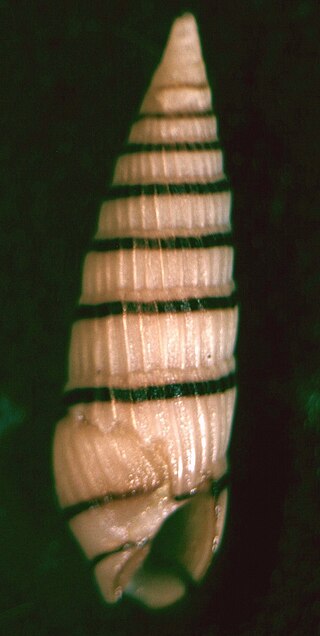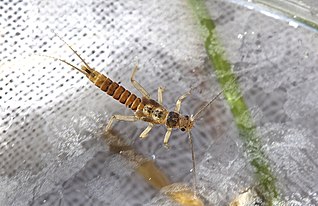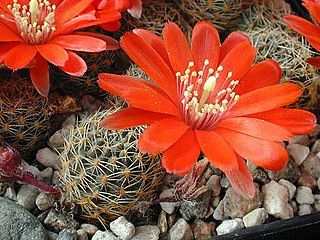
The genus Spilogale includes all skunks commonly known as spotted skunks. Currently, there are four accepted extant species: S. gracilis, S. putorius, S. pygmaea, and S. angustifrons. New research, however, proposes that there may be up to seven.

Pygmy marmosets are two species of small New World monkeys in the genus Cebuella. They are native to rainforests of the western Amazon Basin in South America. These primates are notable for being the smallest monkeys in the world, at just over 100 g (3.5 oz). They are generally found in evergreen and river-edge forests and are gum-feeding specialists, or gummivores.

The pygmy nuthatch is a tiny songbird, about 10 cm (4 in) long and about 10 grams in weight.

Hesperocyparis pygmaea, the Mendocino cypress or pygmy cypress, is a taxon of disputed status in the western cypress genus. It is endemic to certain coastal terraces and coastal mountain ranges of Mendocino and Sonoma Counties in northwestern California. It is a variable tree, and closely related to Hesperocyparis abramsiana and Hesperocyparis goveniana, enough to sometimes be considered conspecific with them.
Urangela is a monotypic moth genus in the family Cosmopterigidae described by August Busck in 1912. It contains only one species, Urangela pygmaea, described by the same author in the same year, which is found in Panama.
The pygmy bamboo bat is a species of vesper bat in the family Vespertilionidae. It is found in Southwest China and was discovered in 2007. The species is around 4 cm (1.6 in) long and weighs between 2.6 and 3.5 g.

Myurella pygmaea, common name the pygmy auger, is a species of sea snail, a marine gastropod mollusk in the family Terebridae, the auger snails.
Laevilitorina pygmaea is a species of sea snail, a marine gastropod mollusk in the family Littorinidae, the winkles or periwinkles.

Rohaniella is a genus of moths in the family Saturniidae. The genus was erected by Eugène Louis Bouvier in 1927.

Rohaniella pygmaea, the pigmy emperor, is a moth of the family Saturniidae. It is found in Africa, including Namibia and South Africa. The species was first described by Peter Maassen and Gustav Weymer in 1885.
Microcladia is a genus of moths in the family Megalopygidae.
The pygmy pikeconger or pygmy duckbill eel, is an eel in the family Nettastomatidae. It was described by David G. Smith and James Erwin Böhlke in 1981. It is a marine, tropical eel which is known from the western central Atlantic Ocean, including Venezuela and the Gulf of Mexico, and possibly more locations. It is known to dwell at a depth range of 128 to 280 meters. Males can reach a maximum total length of 20.1 centimeters (7.9 in).

Yoldia is a genus of marine bivalve mollusks in the family Yoldiidae. It was named after Alfonso de Aguirre y Yoldi, Conde de Yoldi (1764–1852), a Spanish nobleman in charge of the royal naturalistic collection of Denmark.
Alstroemeria pygmaea, also known as the peruvian lily, is a species of small monocotyledonous plant in the genus Alstroemeria, and in the family Alstroemeriaceae. A. pygaea was described by William Herbert in 1837. The species leaves are a gray-green color with one deep yellow flowers. The leaves stems are narrow and are twisted at the base with thick tuberous roots.

Allocapnia pygmaea, the pygmy snowfly, is a species of small winter stonefly in the family Capniidae. It is found in North America.

Paectes pygmaea, the pygmy paectes, is a moth in the family Euteliidae. The species was first described by Jacob Hübner in 1818. It is found in North America.

The western pygmy marmoset is a marmoset species, a very small New World monkey found in the northwestern Amazon rainforest in Brazil, Colombia, Ecuador, and Peru. It was formerly regarded as conspecific with the similar eastern pygmy marmoset, which has whitish underparts. Although the western pygmy marmoset occurs further west than the eastern pygmy marmoset, the primary separators of their ranges are the Amazon River and Marañón River, with the western occurring to the north of them and the eastern to the south.

Aylostera pygmaea, synonyms including Rebutia pygmaea, is a species of cactus in the genus Aylostera, native to Bolivia and northwest Argentina. It has gained the Royal Horticultural Society's Award of Garden Merit.

Canthigaster pygmaea, commonly known as the pygmy toby, is a species of pufferfish in the family Tetraodontidae. It is known only from the Red Sea, where it occurs at a depth range of 2 to 30 m. It inhabits coral reefs and is very secretive, often being found hidden in small holes. It is a small oviparous fish, reaching 5.6 cm in total length.











